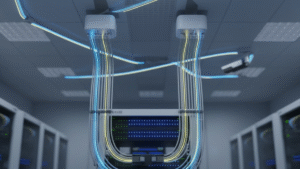The first thing I learned as a product designer was this: performance means nothing if the power supply can’t keep up.
Switching power supplies are more efficient, compact, and versatile, making them the preferred choice for most modern electronic products.

Sometimes it’s not just about saving space or passing certification. The type of power supply you choose can completely change your product’s reliability and cost. That’s what I found out years ago when working on a project that failed testing—not because of the device itself, but because the linear power supply ran too hot.
Are switching power supplies really more efficient?
It’s frustrating to lose performance to heat or waste when you’ve worked so hard on the product design.
Switching power supplies typically offer 80-90% efficiency, compared to 30-60% for linear power supplies. This means less energy is lost as heat, saving space and cost.

Why efficiency matters in every design
When you’re building a new mobile device, tablet, or embedded sensor, you’re already under pressure to meet performance targets in a limited footprint. Linear power supplies are simpler, but they waste more energy as heat. That heat needs to be managed with heatsinks or ventilation, which takes up space, increases BOM cost, and introduces potential failure points.
Switching power supplies convert power using high-frequency switching regulators. This allows them to maintain output voltage over a wide range of input conditions. The result is less heat and higher efficiency, which not only improves reliability but also helps meet energy regulations like DOE VI.
Here’s a quick comparison:
| Feature | Linear Power Supply | Switching Power Supply |
|---|---|---|
| Efficiency | 30–60% | 80–90% |
| Heat generation | High | Low |
| Size and weight | Larger | Compact |
| Noise | Very low | Higher (but manageable) |
| Cost (unit price) | Lower | Slightly higher |
| Application fit | Simple loads | Most modern electronics |
Are they harder to design into products?
You don’t want to spend weeks tweaking EMI filters just to make your adapter pass.
While switching power supplies need more attention to EMI and layout, modern modules and certified adapters simplify this process greatly.

How I solved our EMI problem with a certified switching module
Years ago, I worked on a wearable product that used a custom board-mounted DC/DC converter. We hit EMI issues in pre-cert testing and spent weeks re-routing traces and adding filters. If I had used a certified wall adapter module with internal shielding and EMC compliance, we would’ve saved two weeks and thousands in rework.
Switching power supplies do require care. They can generate switching noise, and that can interfere with nearby circuits, especially analog sensors or RF modules. But today, the market is filled with off-the-shelf switching power supplies that already meet EN55032 and FCC Class B standards. Some even have medical-grade isolation and 2xMOPP certification.
The lesson? Choose the right module, and most of the hard work is already done. For time-to-market, it’s not worth reinventing the power architecture if a certified module already exists.
Are switching power supplies more reliable in the long run?
You can’t afford field failures—especially if your device ships in thousands of units globally.
Switching power supplies generally last longer due to reduced thermal stress, better voltage regulation, and built-in protection features.
Where reliability really shows: global deployment
I once supported a product rollout in Southeast Asia, where input voltages varied wildly between rural and urban areas. Devices with linear power supplies failed often. Those with switching supplies held up. Why? Because switching power supplies can operate from a wide input range (like 90-264V AC), and they include overvoltage, overcurrent, and thermal shutdown protections.
With linear supplies, high input voltages mean more power is dissipated as heat. That accelerates component aging. Switchers, on the other hand, only draw the power they need. Less heat means capacitors and semiconductors last longer. And most commercial-grade switching supplies are tested at 105°C environments for 50,000+ hours MTBF.
That’s a big deal if you’re designing a product expected to last 5–7 years in the field.
Do switching power supplies really save cost?
It feels counterintuitive—how can something more complex end up saving money?
Despite a higher unit price, switching power supplies reduce overall costs through better efficiency, smaller size, less heat management, and lower failure rates.
Let’s break down the real cost equation
Many teams look only at the BOM and see switching adapters as the more expensive option. But that’s a short-sighted view. Once you factor in the cost of extra heatsinks, larger enclosures, thermal pads, and certification failures from a linear design, the switching power supply often wins out.
For instance, a switching adapter may cost $0.80 more, but it can save $2–$3 in other areas:
- Smaller enclosure size = lower plastic costs
- Better thermal profile = no heatsink or fan needed
- Lower EMI emissions = faster lab certification, fewer redesigns
- Higher reliability = fewer warranty claims and returns
So yes, you pay a little more upfront—but you gain speed, stability, and long-term cost savings.
Conclusion
Switching power supplies aren’t just better—they’re smarter, more reliable, and the clear choice for modern product design.




